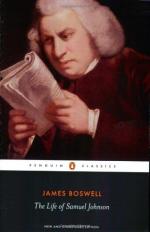|
This section contains 5,409 words (approx. 19 pages at 300 words per page) |

|
SOURCE: "The Rhetoric of Fear and of Hope," in Triquarterly, Vol. 11, Winter, 1968, pp. 109-23.
In the following essay, Hagstrum analyzes the philosophical positions on the nature of fear and hope advanced by Samuel Johnson and William Blake.
In 1749 Samuel Johnson, often considered the last classical rationalist, asked, "Where then shall Hope and Fear their objects find?" In 1793 William Blake, sometimes called the first Romantic, declared, "Fear & Hope are—Vision."
These famous sentences seem to unite the two qualities. But by nature fear and hope, like volatile gases, tend to fly apart or consume one another. Indeed, to keep them together or even to keep them safely interacting requires strenuous doing. One of our authors, in order to cast out destructive fear, had to create a rhetoric of hope, and the other, in order to tame delusive hope, had to create a rhetoric of fear. That kind of separation...
|
This section contains 5,409 words (approx. 19 pages at 300 words per page) |

|


